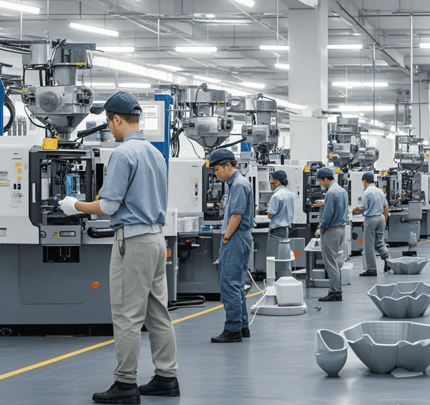The Future of Mold Manufacturing: Trends and Opportunities
The mold manufacturing industry is at a pivotal moment, driven by technological advancements, changing consumer demands, and a growing emphasis on sustainability. As we look to the future, it's clear that the landscape of mold manufacturing is evolving rapidly, presenting both exciting opportunities and new challenges. This article explores the key trends shaping the future of mold manufacturing and how businesses can adapt to thrive in this dynamic environment.
9/18/20242 min read


# The Future of Mold Manufacturing: Trends and Opportunities
## Introduction
The mold manufacturing industry is at a pivotal moment, driven by technological advancements, changing consumer demands, and a growing emphasis on sustainability. As we look to the future, it's clear that the landscape of mold manufacturing is evolving rapidly, presenting both exciting opportunities and new challenges. This article explores the key trends shaping the future of mold manufacturing and how businesses can adapt to thrive in this dynamic environment.
## 1. Technological Innovations
### 1.1 Automation and Smart Manufacturing
The rise of automation and smart manufacturing is revolutionizing mold production. Advanced robotics and AI-driven systems are enhancing efficiency and precision. Key benefits include:
- Increased Productivity: Automated processes reduce cycle times and minimize human error.
- Real-Time Monitoring: IoT technologies allow manufacturers to monitor equipment performance and predict maintenance needs, reducing downtime.
### 1.2 Additive Manufacturing
Additive manufacturing, or 3D printing, is gaining traction in mold production. This innovative approach offers several advantages:
- Rapid Prototyping: 3D printing enables quick iterations of designs, speeding up the development process.
- Complex Geometries: The ability to produce intricate mold designs that traditional methods cannot achieve, leading to enhanced product capabilities.
## 2. Sustainability and Eco-Friendly Practices
### 2.1 Green Materials
Sustainability is becoming a core focus in mold manufacturing. The industry is shifting towards eco-friendly materials, such as biodegradable plastics and recycled polymers. This trend aligns with growing consumer demand for environmentally responsible products.
### 2.2 Energy Efficiency
Manufacturers are prioritizing energy-efficient practices to reduce their carbon footprint. This includes:
- Upgrading Equipment: Investing in energy-efficient machinery that lowers power consumption during production.
- Optimizing Processes: Streamlining workflows to minimize waste and energy use, which not only benefits the environment but also reduces operational costs.
## 3. Customization and Market Diversification
### 3.1 Tailored Solutions
As industries increasingly seek unique and customized products, the demand for specialized molds is on the rise. Key considerations include:
- Flexible Production: Adapting production processes to accommodate small batch sizes and custom designs.
- Responsive Design: Collaborating closely with clients to deliver tailored solutions that meet specific requirements.
### 3.2 Expanding into Niche Markets
Emerging industries, such as electric vehicles and advanced healthcare applications, are driving the need for specialized molds. Manufacturers can capitalize on these trends by:
- Investing in R&D: Exploring new materials and technologies to create molds that meet the specific needs of these sectors.
- Building Expertise: Developing specialized knowledge in high-demand areas to differentiate from competitors.
## 4. Globalization and Supply Chain Dynamics
### 4.1 Global Market Opportunities
The mold manufacturing industry is increasingly interconnected. Manufacturers can tap into global markets, providing opportunities for growth and expansion. This requires:
- Adaptability: Being able to respond to varying market demands and regulatory standards across different regions.
- Strategic Partnerships: Forming alliances with suppliers and distributors to enhance market reach and efficiency.
### 4.2 Resilience in Supply Chains
Recent global events have highlighted the importance of resilient supply chains. Businesses should focus on:
- Diversifying Suppliers: Reducing dependency on single sources to mitigate risks.
- Investing in Local Production: Exploring opportunities for local manufacturing to improve supply chain stability and responsiveness.
## Conclusion
The future of mold manufacturing is bright, characterized by innovation, sustainability, and customization. By embracing new technologies, prioritizing eco-friendly practices, and adapting to changing market demands, businesses can position themselves for success in this evolving landscape. As the industry continues to grow, those who proactively respond to these trends will find ample opportunities to thrive.
